Fixed-income investments, which consist of bonds, money market funds, and certificates of deposit (CDs), are considered a low-risk approach to investing. The primary goal of these investments is to produce steady returns on investment. Many people depend on their investments for steady returns as they approach retirement, so they may consider moving their portfolios toward a fixed-income strategy.
Generally, investing in fixed-income assets is less risky than investing in growth-oriented securities such as equities. But that does not mean that this investment strategy is risk-free. Let us walk you through the essential details of investing in fixed-income securities.

How Does Fixed Income Investments Work?
Investment returns on fixed-income securities are certain. Once a company introduces them to the market, they serve as a liability. The interest payable on fixed-income assets remains unchanged, regardless of the market’s fluctuations. Moreover, the returns are earned periodically.
Pre-issued calculations estimate the fixed-income security’s final value at maturity. Investors are informed about such market investments whenever they make them. Such investments are attractive to those who prefer safe returns with higher yields over exposure to risks.
Types of Fixed Income Securities
Debt Mutual Funds
The collected corpus of these funds will be invested in several fixed-income assets, such as corporate and government bonds, commercial papers, corporate bonds, and money market instruments.
When compared to savings strategies such as fixed deposits and savings accounts held with banks or different financial organizations, debt mutual funds possess the main benefit of providing higher returns on investments.
Exchange Traded-funds
Bond exchange-traded funds earn income by investing in various debt securities that are put on the market and produce fixed and regular returns. Since returns are given out regularly at a fixed interest rate, they guarantee stability. Retired or risk-averse individuals prioritizing stability over market benefit are more interested in fixed-income assets.
Bank Deposits
Bank deposits or fixed deposits are among the safest investment options. For the investor, these fixed-income tools can be available for a short or extended period.
Nevertheless, investments made via bank deposits are non-refundable before the maturity date. Early withdrawal is permitted in emergencies, but it will be costly. Moreover, the government offers a range of fixed-income bonds that investors can add to their portfolios.
Bonds
Bonds are among the most common fixed-income securities that companies issue to fund their regular operations and ensure a smooth production run.
Fixed-income bonds must be redeemed soon after the company produces adequate income, as they represent a liability for the issuing corporation.
Public Provident Fund
Compared to regular savings strategies, investing in such securities offers a much higher interest rate and is free from deductions of taxes. The PPF is a central government-sponsored initiative; therefore, no risks are involved.
Money Market Tools
Fixed-income securities are money market tools such as commercial papers, certificates of deposits, and treasury bills that offer investment possibilities at a fixed interest rate. Generally, their maturity period exceeds a year, and they are only available for a short time frame.
Bonds of Listed Public Sector Unit
Top-performing public sector units across the nation offer these investments, which are considered one of the most popular fixed-income assets. These bonds offer higher returns and involve minimal risk.

Fixed Income Investing’s Pros and Cons
Pros
Steady Returns
Knowing the amount of money that fixed-income investments will produce could streamline your retirement planning process. As a result, you can plan your expenses according to the exact amount of money you can expect from your investments.
Protection From Market Fluctuations
Fixed-income investments have several benefits, including protection from market fluctuations. If you’re retired and looking for alternatives to making an income while dealing with a volatile economy, this can be well worth your investment.
Retirement investors cannot tolerate volatility and might eventually sell and repurchase stocks in the most distressing times. You can add bonds to portfolios to minimize short-term volatility. The theory is that you will take on half of the market risk if your portfolio has 50 percent bonds.
Tax Benefits
Certain fixed-income assets, especially those issued by the government, come with several tax benefits, which can significantly reduce your tax burden.
Cons
Interest Rate Risk
Bond prices drop as interest rates rise. The bond value will decrease if you choose to sell it before it matures, as it will be competing against goods with more significant earning potential. There may not be a price reduction for specific fixed-income tools like CDs. However, a penalty may apply if you close a bank CD early.
Lower Returns
Given their relative safety, fixed-income investments yield lower returns than riskier assets like equities. Consequently, you might miss out on the considerably significant gains that equities could offer.
Cash Access Issues
Withdrawing money from your savings account is not the only way to access your fixed-income assets. The market will revalue the bonds, considering the current interest rates. Therefore, you may be forced to sell them at a loss if you need to before they mature and rates rise.



